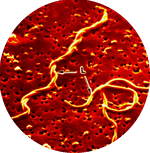Borrelia burgdorferi
- Organism Specific Information
- Concatenate Sequences
- Download Alleles
- Download ST’s
- Compare profile to refset
- Draw tree using own MLST data
- eBURST
- MLST-MAPS
- B.burgdorferi Links
- Contact Curator
The B.burgdorferi MLST scheme was developed by Gabriel Margos, Liliana Vitorino, Annie Gatewood, Klara Hanincova ,Klaus Kurtenbach et al. REF: Click here
This site is hosted at Imperial College and development is funded by the Wellcome Trust
Borrelia burgdorferi is a bacterial species of the spirochete class of the genus Borrelia. Representatives of the genus are causative agents of human diseases, such as borreliosis, mainly of a zooanthroponous nature with a transmissible transmission of the pathogen.
The genus was named after the French physician and bacteriologist Amadeus Borrel.
Representatives of the genus have an elongated shape: their length is from 11 to 25 microns, width – from 0.18 to 0.25 microns. Borrelia looks like twisted springs; covered with cilia.
Diseases produced by Borrelia burgdorferi
This species of Borrelia cause various diseases in humans: borreliosis, Lyme disease, and relapsing fever.
The main carriers of Borrelia burgdorferi are:
- ixodid ticks from the genus Ixodes, including Ixodes ricinus and Ixodes scapularis, Ornitodorus papillares and Argas persicus;
- human and pubic louse.
Lyme disease
Lyme disease is transmitted mainly by mites of the genus Ixodes. Borrelia enters the skin of a person along with the saliva of a sucking ixodid mite. They move in human tissues and can penetrate into many types of cells, including cells that already contain other pathogens (for example, mite-borne encephalitis virus or rickettsia). Borrelia causes inflammation in various internal organs of a person (arthritis of joints, paresis of muscles), while the external manifestations of the presence of borrelia in the body can vary greatly in different patients. The mechanism of inflammation is usually quite typical for a given organ; therefore, the presence of borrelia in the human body can be reliably determined only by a blood test.
Relapsing fever
Typhoid fever Borrelia is often accompanied by bacteriemia. Borrelia burgdorferi penetrates the human body through a bite of an infected insect. Propagation of the bacterial agent occurs in the intestines of lice.
To diagnose relapsing fever, a patient needs to undergo an immunofluorescence examination or a blood test.


